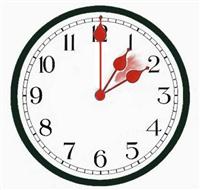On Sunday, March 11, 2012, clocks in the United States (and many others throughout the world) are advanced one hour so that evenings have more sunlight in the warmer months of the year. First established in 1918, “Daylight Saving Time” allows for people to take advantage of sunlight later in the day, as well as encourage energy savings. As days become shorter again in fall and winter months, clocks are returned to “standard” time so that there is more sunlight in the mornings.

Although Daylight Saving Time has been around for nearly 100 years in the United States, there is still a good deal of controversy surrounding the practice. Many critics feel that Daylight Savings is not beneficial, or simply too complicated. Worldwide, many countries use Daylight Savings in order to conserve daylight; the days of change, however, often differ from country to country (most of Europe changes on the last Sunday in March, while much of Oceania changes on the first Sunday in April). Other countries, such as large portions of Africa and Asia have opted to stop using Daylight Savings Time, or have simply never used it at all.
In the US, Daylight Savings occurs on the second Sunday of March, and ends on first Sunday of November. Daylight Savings is easily remembered with the mnemonic device, “spring forward, fall back” to help people remember which direction to shift the clocks for each time period.
Sources:
